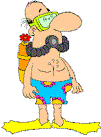Underwater Photo Location: Aquaba reefs
How Hot is this Dive Site? click a star to rate it
- FIRST BAY: Situated next
to the Marine Science Station, this a shallow fringing reef with very prolific
coral and fish life, the reef starts at 2m/6’ and extends down to 30-40m and
beyond. There is a small area of upwelling that attracts shoaling fish. Sea
bass, shoals of fusiliers, schools of squid and octopus are common making this
an excellent site for photographers. This is a more advanced dive
site.
- BLACK ROCK:
This site provides very easy access and is ideal for
snorkelers and anyone who is new to the area, as a coral garden starts just
below the surface and extends outwards for approximately 30m when it drops away
steeply. The reef is prolific with a wide range of fish and is regularly visited
by turtles.
- GORGONE ONE:
This is a relatively shallow site, generally (10m) though
is named after a large gorgonian fan coral which is at 16mtrs. This site has
splendid examples of massive coral formations, including a 'lettuce coral' the
size of a small house. There are lots of rock pinnacles smothered in fish life,
with a large range of both hard and soft corals covered in Lionfish which gather in huge numbers to hunt for fry. This site is a photographer’s paradise and an
ideal site for second dives.
- EEL CANYON:
This site is aptly named and provides a dramatic dive with
lots of variation in invert life, it has the advantage of lots of large coral
outcrops that offer a variation in depth and contour.
- BLUE CORAL:
Fingers of coral extending at right angles to the coast.
Covered with a profusion of fish and coral life. You also will not have to look
very hard to discover the abundance of small, gray morays. This site also has
the rare fluorescent anemones, but be warned they look muddy brown if
photographed with a strobe.
- SAUDI BORDER:
(The Drop Off) This site is so called because it is just
that, you could swim into Saudi Arabia from here, but don't try it! The top of
the reef starts at 5m/15’ with patch reef and the reef top itself extends
approx. 30-40m/100-120’ seaward at a depth of 10-20m. At this point a wall of
living coral drops down to 50m and beyond. There are small caverns at 30m and
large plate corals abound. At around 40m a large Grouper is to be found hiding
behind a rock pinnacle. Along the reef edge it is common to see turtles. The
sand is home to some large rays and deep water shoaling fish, such as Jack and
Tuna can be seen.
- POWER STATION:
Here the reef drops from the surface to 5M/15’ then
slopes to 12M/36’ before dropping vertically to 200M/320’ in a sheer wall.
Swimming along the edge of the wall offers spectacular views and large pelagic
species make this their hunting ground. Soft corals abound as nutrient rich
waters gently flow along the wall. This dive requires good buoyancy control and
offers some spectacular coral outcrops with huge numbers of fish. The dive can
be completed in shallow water between 12 and 5 M, where an abundance of varied
hard corals each with its attendant species, keep divers entertained.
- PARADISE:
A gentle slope with patch corals leads to a pinnacle and cave
at the edge of a wall in 30M/100’. Working back up to the south we encounter
soft coral gardens at 10-15M/30-45’. Stingrays and eagle rays are common in
this area.
- OLIVERS CANYON:
Swim out to 12M/36’ where the reef starts with a gully
dropping down to 30M. The top of the reef is covered in table corals, where
Scorpion, Stone and Crocodile fish abound.
Don’t Miss… The ancient city of Petra about two hours North of Aqaba. Facts about Aquaba reefs It is in Jordan It is in Jordan- Aquaba reefs is in the Red Sea.
- The typical depth is 0-30 Metres 0-100 Feet.
- The typical visibility is 3-10 Metres 10-30 Feet.
| Dive types |   |
| Diving facilities |   |
| Photo facilities |   |
 Share your knowledge... Share your knowledge...
|